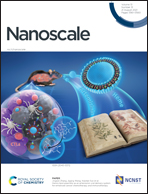Second near-infrared photoactivatable biocompatible polymer nanoparticles for effective in vitro and in vivo cancer theranostics†
Abstract
Photoacoustic imaging (PAI)-guided photothermal therapy (PTT) has drawn considerable attention due to the deeper tissue penetration and higher maximum permissible exposure. However, current phototheranostic agents are greatly restricted by weak absorption in the second near-infrared (NIR-II, 1000–1700 nm) window, long-term toxicity, and poor photostability. In this report, novel organic NIR-II conjugated polymer nanoparticles (CPNs) based on narrow bandgap donor–acceptor BDT-TBZ polymers were developed for effective cancer PAI and PTT. Characterization data confirmed the high photothermal conversion efficiency, good photostability, excellent PAI performance, and superior biocompatibility of as-obtained CPNs. In addition, in vitro and in vivo tests demonstrated the efficient PTT effect of CPNs in ablating cancer cells and inhibiting tumor growth under 1064 nm laser irradiation. More importantly, the CPNs exhibited rapid clearance capability through the biliary pathway and negligible systematic toxicity. Thus, this work provides a novel organic theranostic nanoplatform for NIR-II PAI-guided PTT, which advances the future clinical translation of biocompatible and metabolizable conjugated nanomaterials in cancer diagnosis and therapy.



 Please wait while we load your content...
Please wait while we load your content...